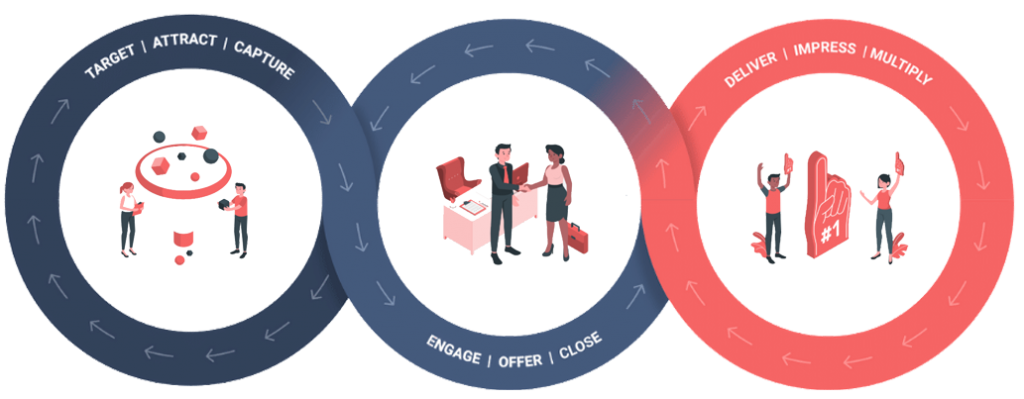Business in the age of the internet and social platforms inevitably had to pave the way for a marketing model like lifecycle marketing, where the customer journey is more cyclical and the customer lifecycle is regenerative. As a mortgage business, you aim to become part of your prospects’ and customers’ journey.
Welcome to the post-AIDA (awareness, interest, desire, action) marketing era.
Here, automation and multiple marketing channels make it so much easier to collect and nurture leads, convert and impress clients, and create long-term fans and ambassadors for your brand/business (that is, of course, as long as you keep on delivering).

The lifecycle marketing model
Lifecycle marketing is designed to systematically grow businesses through a waste-proof approach to collecting leads, converting clients/customers, and creating fans. Each of these three areas are further organized into 3 steps to ensure a successful lifecycle marketing strategy at every stage.
The 3 steps in collecting leads
Target
This process is crucial for ensuring that you’re able to tailor your messaging for the right audience.
When you target leads, your goal is to get a clear idea of who you want for a client. Once you know who you’re after, you can work on understanding them to accurately identify what drives them and the pain points they’re dealing with. At this stage, you determine where they turn to for answers and solutions—and whether the answers and solutions they’re getting are exactly what they need.
Attract
Armed with a clear idea of who your target customer is, you can now create high-value content that is especially designed to address their biggest pains and empower them to achieve their goals. (For example, you can educate your prospects on the two most common mortgages: the fixed-rate mortgage and the adjustable-rate mortgage.)
Capture
At this stage, you develop unbeatable lead-capture methods that facilitate a centralized collection of contact details for easier subsequent follow-up. You’ll see what wonders automation can do for your momentum (as well as sanity, come to think of it).
The 3 steps in converting clients
Engage
Engagement is easy with trust. Trust is achieved when you establish your authority through knowledge about your industry and capability to provide solutions—not just to your existing clients but to those who you have yet to convert from prospect to paying customer. The best way to engage your prospects is to educate them.
Offer
At this stage, presenting just any offers is not the way to go. By this time, you should already know who your prospects are, what their needs are (especially the most important), how much they would likely be willing to spend.
Your offers should dovetail nicely with these factors to move them along to the next logical step.
Close
Streamlining and simplification are key at this stage. Client purchases should be free of hassle, confusion, and doubt. Implementing strategies that align with your sales cycle.
The 3 steps in creating fans
Deliver
When you deliver, make sure you deliver. To do this, systemize your delivery to ensure that clients consistently get everything they were sold.
Impress
This step should secure these three things: repeat business, positive reviews and customer referrals. It’s largely dependent on the preceding step.
Multiply
At this stage, not only have your repeat clients established your loyalty, but they will have played a crucial role in spreading the word about you and helping bring in more leads. Ideally, these new leads will also go through the same steps above all the way to here. And on it goes.
Contact LeadsRush today.
Let’s work together to integrate lifecycle marketing into your mortgage business growth strategy.

